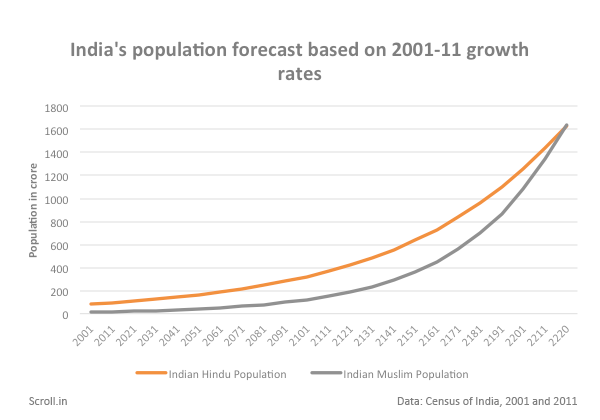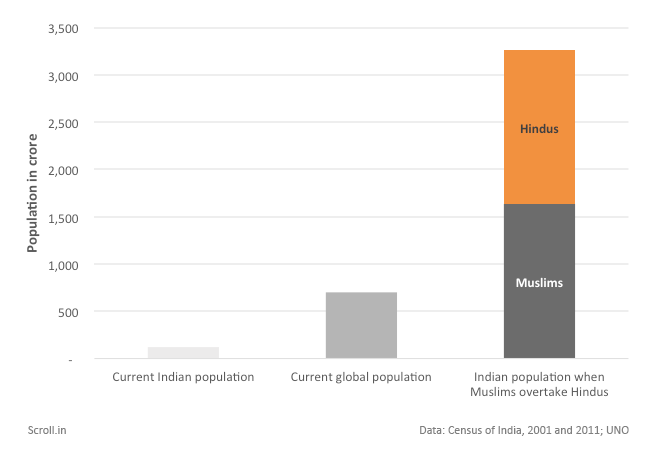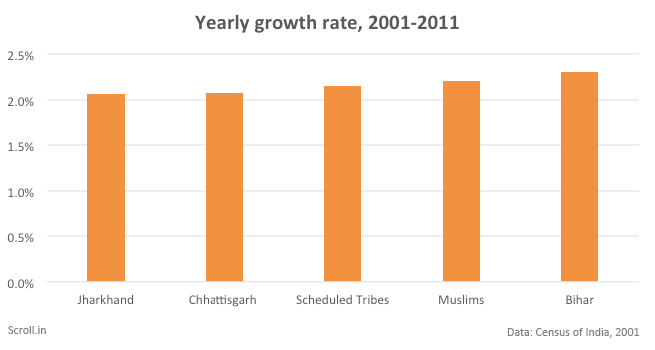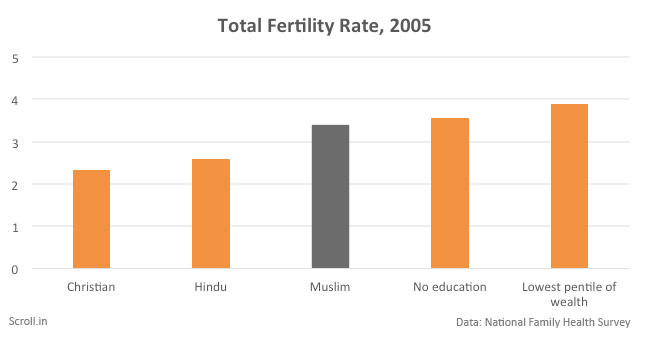
5 Charts That Puncture The Bogey Of Muslim Population Growth In India
Last week, a report was released by the Pew Research Center and it was predicted that India will overtake Indonesia as the country with the largest Muslim population has set off the usual suspects. In response, the Vishwa Hindu Parishad on Saturday asked Hindus to have more children to rectify this “demographic imbalance” and predicted that soon Muslims will overtake the number of Hindus in India. his is nothing new, of course. Malthusian fears of a Muslim takeover of India have been a core part of the Hindutva agenda for almost a century now. After the 2002 Gujarat pogrom, for example, Narendra Modi characterised the violence-affected Muslims in riot camps as “baby-producing factories”.
Bogey #1: Muslims will overtake Hindus
This is an extremely famous notion in the Sangh Parivar.Before the statements of Vishwa Hindu Parishad on Saturday, this statement was last bought up by the Bharatiya Janata Party’s Sadhvi Prachi, who accused Muslims of giving birth to “40 dogs” each and “trying to convert Hindustan into Darul Islam” in February . Infact, the growth rate of Muslim population is higher than the Hindu community. According to the data released by 2011 Census,Hindus grew at an average annual rate of 1.4% between 2001 and 2011 and for Muslims it was 2.2%. If the same continues Muslims will reach Hindu population by 2220, which is around 200 years. 
If the Muslims overtakes Hindus at these rates,India’s population would need to be almost five times the current global population which is clearly an impossible scenario.  At some point of time in future, Muslim growth rates slow down and the population will stabilise. From 1991 to 2001, the Indian Muslim population grew by 29.3%, in the period 2001-2011, it grew by 24.4% a fall in population. According to Sachar Committee Report, it is estimated that the Muslim proportion will stabilise at between 17% and 21% of the Indian population by 2100.
At some point of time in future, Muslim growth rates slow down and the population will stabilise. From 1991 to 2001, the Indian Muslim population grew by 29.3%, in the period 2001-2011, it grew by 24.4% a fall in population. According to Sachar Committee Report, it is estimated that the Muslim proportion will stabilise at between 17% and 21% of the Indian population by 2100.
Bogey #2: The Muslim growth rate is abnormal
The main reason behind the high population growth rate is that the poor economic conditions of Muslims. However, the Hindutva explanation for this growth, expectedly, blames religious factors and dismisses the economic drivers. To quote Hindutva Indologist, Koenraad Elst: “Muslims will have a markedly higher birth rate than their Hindu counterparts, even to the extent of having a higher birth rate than Hindus in a lower educational or income bracket.” The data tells a different story.The below chart shows the comparasion in between the other groups population and Muslims growth rate. 
Muslim infant mortality is lower than other population segments, this effect can even be seen in the Total Fertility Rate (or number of births per woman).  As expected the Muslim Total Fertility Rate is higher than that for Hindus and Christian.But when we segment the population socio-economically, we see that Muslims manage to be better off than people without any education.Clearly, economic and educational factors plays major role. We could also disprove the Hindutva groups’ religious argument by looking at the global scene. Iran, for example, achieved replacement level fertility (with each new generation being less populous than the one before) in 2002, a goal India will only reach in 2020. With a population that is more than 90% Muslim, Bangladesh has a TFR not only lower than India’s overall but also lower than India’s Hindus.
As expected the Muslim Total Fertility Rate is higher than that for Hindus and Christian.But when we segment the population socio-economically, we see that Muslims manage to be better off than people without any education.Clearly, economic and educational factors plays major role. We could also disprove the Hindutva groups’ religious argument by looking at the global scene. Iran, for example, achieved replacement level fertility (with each new generation being less populous than the one before) in 2002, a goal India will only reach in 2020. With a population that is more than 90% Muslim, Bangladesh has a TFR not only lower than India’s overall but also lower than India’s Hindus.
Bogey #3: Bangladeshi Immigration
Allegations of large-scale Bangladeshi immigration is one of the supposed reason for the alleged Muslim population boom, along with polygamy (which in itself is untrue). If, as alleged, such large-scale immigration was taking place from Bangladesh to Assam and West Bengal, the Muslim population in those two states would tend to show abnormal growth. But the data shows nothing of that sort. 
Assam’s Muslim population, for example, grew at the same rate as India’s Muslim population between 1991 and 2001 and West Bengal’s Muslim population, in fact, grew slower. The abnormal growth rate that Assam’s and West Bengal’s Muslim populations should show, given the alleged massive Bangladeshi immigration, simply has not happened.Assam’s Muslim population, for example, grew at the same rate as India’s Muslim population between 1991 and 2001 and West Bengal’s Muslim population, in fact, grew slower. The abnormal growth rate that Assam’s and West Bengal’s Muslim populations should show, given the alleged massive Bangladeshi immigration, simply has not happened.
This article is originally published on Scroll.in